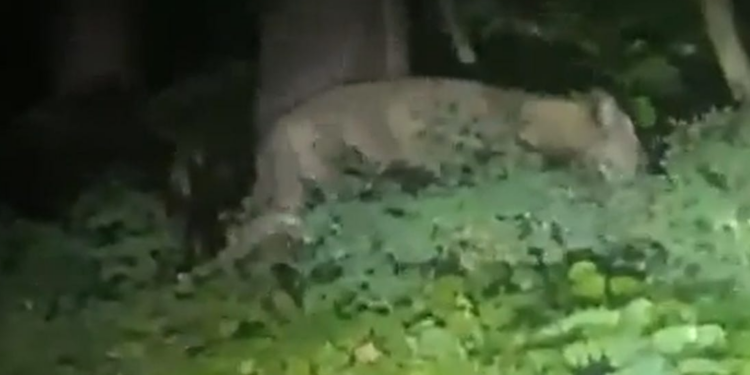The following is completely true; all details come from the breathless t-online blog of events as they unfolded over Thursday and Friday. I swear that I am not making any of this up.
At 5am on Thursday morning, a grainy video purporting to show a lioness in the woods near Kleinmachnow, a town in the district of Potsdam-Mittelmarkt near Berlin, made the rounds on German Twitter.
Authorities, who alas are also on Twitter, deemed the footage genuine and ordered a massive search for the hostile carnivore, involving at points at least two helicopters and a hundred or more policemen. Officers inquired at zoos and circuses for missing animals, but all local lions were accounted for. A local Veterinary Office explained that it was most likely an illegally kept pet which had escaped. As the search continued to come up empty – a police spokesman explained that the lion had likely found a nice wooded place to sleep – authorities extended their alarm from the southern towns of Teltow, Stahnsdorf and Kleinmachnow to neighbourhoods in south Berlin. They urged all residents to keep their windows and their doors locked, lest the clever feline awaken from its morning nap and try to open them.
Municipal officials in hardest-hit Kleinmachnow told journalists they would order no closures, at least for the moment. Day cares would continue to operate, but children shouldn’t leave the yard, nor should merchants set up their usual stands at the local Thursday market. Police reported they were happy to see residents following their recommendations, and journalists confirmed that hardly anybody was to be seen on the street.
Michael Grubert, the Mayor, assured his terrified constituents that the risk was minimal, “so long as you follow police advice, which means you don’t go for a walk in the woods, you just go straight to the car”. The press speculated about whether the lion would have to be shot, and officers armed with machine pistols patrolled the roads and the woods – not, journalists assured their readers, in orderly ranks, but instead carefully staggered, so that if the lion were to stage an ambush, it could take no more than a few of them out at once.
By noon on Thursday, seven hours into the emergency, Grubert briefed the press in a crisis session. The police still had yet to find the lion, he explained, though they were now bringing drones and thermal imaging cameras to bear on the problem. He expressed gratitude that holidays had already begun and that children did not require special protection on the way to school.
Concerned journalists soon noticed, as Panic Thursday dragged on, that nobody in the Neukölln neighbourhood of Berlin was taking the news seriously, although they were technically within the bounds of the Lion Emergency Zone. Many residents said they hadn’t even heard anything about a lion. Only a few dogwalkers could be found to voice the vague anxiety that it might eat their pets. Mysteriously, right after these reports of indifference hit the internet, lion sightings began occurring in south Berlin. Police deemed them “credible” and dispatched armed units to investigate. Other sightings sent officials to a cemetery in Zehlendorf; police vehicles entered the grounds to defend the graves and the gates were sealed. Back in the Kleinmachnow red zone, meanwhile, police announced they would deploy their sole armoured vehicle, a Rheinmetall Survivor, in the hunt for the lurking lioness, who was at this point presumably considered armed.

Civilian sightings intensified into the evening, and townspeople told reporters they could hear ominous roaring in the darkness.
With the search still fruitless by noon on Friday, Kleinmachnow announced that it would cancel the first major events. An outdoor cinema and a concert would be held over the weekend indoors instead of on Friday evening outside.
All the while, there were a few reasonable voices. In the earliest hours of the panic, an association of zoo veterinarians issued a press release explaining that the animal in the Twitter video was not a lion at all. The shape of the head and the rounded back were all wrong. They also noted that school holidays have been occasions for false exotic animal sightings in the past. Employees of a travelling circus also chimed in. They said there were simply no privately held lions around and that a similar false sighting last year had turned out to be a Caucasian Shepherd Dog.
A mere half hour after cancelling outdoor events, Grubert’s lion farce fell apart. The battle-hardened Mayor was compelled to convene another press conference, this one rather more awkward than his earlier performances. The animal experts he’d finally bothered to speak with had explained to him that the video which set off the panic depicted not a lion, but an ordinary boar, of the kind which roam the woods of Europe in abundance. They are not generally dangerous. They eat mainly roots, nuts and garbage.

As I type this, Team Panic clings desperately yet to some straws. Hair and faeces samples secured by the police in their cathunt are undergoing laboratory testing. Results won’t be available until Monday, so there is still some hope that a lion may be at large. And Tagesspiegel has unearthed a random veterinarian named Michaela Ebeling to insist that the video really does too depict a lion, really it does.

This article originally appeared on Eugyppius’s Substack newsletter. You can subscribe here.











To join in with the discussion please make a donation to The Daily Sceptic.
Profanity and abuse will be removed and may lead to a permanent ban.